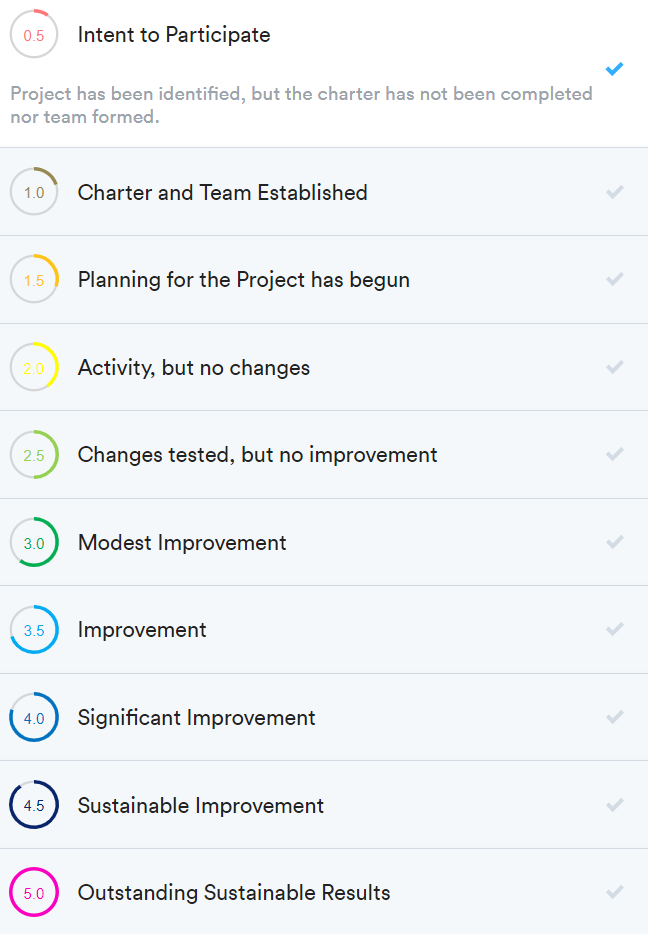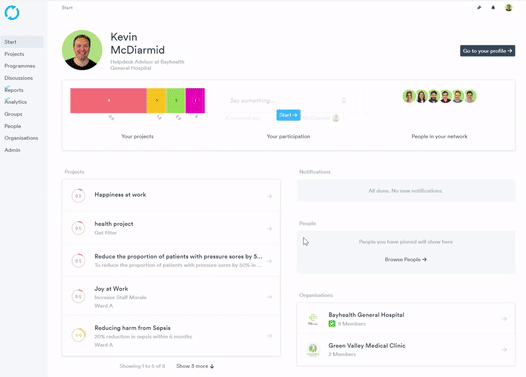To help you capture and communicate your progress towards your project aim, your project has a progress score that you can update throughout the life of the project to reflect the level of progress achieved.
Based on the scale developed by the Institute for Healthcare Improvement (IHI) the scale allows you to track progress right by the intent to participate with a project, right through to outstanding sustainable results.
The project progress score scale:

The full description of each score on the scale is listed at the bottom of this article.
Setting and updating your progress score
Your project progress score will not be updated automatically by Life QI - you have to update it each time you feel your progress warrants changing the score.
You can do this on your General project page by clicking the Change score button, then click the Progress Score field and select the progress score related to your project. Once you have updated the score, click the 'Change score' button at the bottom of the page.
Each time you update the progress score its helpful to leave a new status update at the top of the project General page. This will help your team and organisation understand why the score has changed, and is a great opportunity to compliment them on their hard work to drive the project to the next level!

Reviewing project progress
Progress scores make it easy to review the list of projects and quickly assess where in the project life cycle each one is. So at a glance you know which have just started, which are on their way to great things, and which have already achieved excellent levels of improvement.
You can see these kinds of project lists on your Start page, the Projects list page, and your Organisation's profile page:
As well as showing you the current level of progress, tracking this score over time will allow you to see the rate of progress – this is particularly useful when looking at a collection of projects at a programme or organisation level.
Charts showing project progress scores over time for your organisation are included in the Analytics area:
The progress scores defined:
0.5 - Intent to Participate
Project has been identified, but the charter has not been completed nor team formed.
1.0 - Charter and Team Established
A charter has been completed and reviewed. Individuals or teams have been assigned, but no work has been accomplished.
1.5 - Planning for the Project has begun
Organisation of project structure has begun (such as: what resources or other support will likely be needed, where will focus first, tools/materials need gathered, meeting schedule developed).
2.0 - Activity, but no changes
Initial cycles for team learning have begun (project planning, measurement, data collection, obtaining baseline data, study of processes, surveys etc.).
2.5 - Changes tests, but no improvement
Initial cycles for testing changes have begun. Most project goals have a measure established to track progress. Measures are graphically displayed with targets included.
3.0 - Modest Improvement
Successful test of changes have been completed for some components of the change package related to the team's charter. Some small scale implementation has been done. Anecdotal evidence of improvement exists. Expected results are 20% complete.
3.5 - Improvement
Testing and implementation continues and additional improvement in project measures towards goals is seen.
4.0 - Significant Improvement
Expected results achieved for major subsystems. Implementation (training, communication etc) has begun for the project. Project goals are 50% or more complete.
4.5 Sustainable Improvement
Data on key measures begin to indicate sustainability of impact of changes implemented in system.
5.0 - Outstanding Sustainable Results
Implementation cycles have been completed and all project goals and expected results have accomplished. Organisational changes have been made to accommodate improvements and to make the project changes permanent.